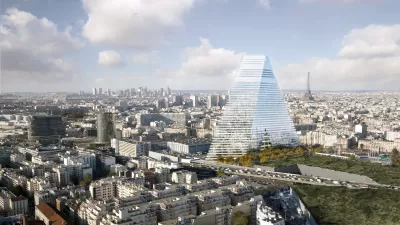Drawing inspiration from Paris and Barcelona, Kaid Benfield offers his take on the recent controversy surrounding height limits in the nation's capital, enumerated point-by-point against arguments over capacity, density, affordability, and beyond.
Established over a century ago, height limits on development in Washington, D.C. have recently come under fire by not a few prominent pundits, from Ed Glaeser to Matt Yglesias to Ryan Avent. But longtime D.C. resident and National Resources Defense Council blogger Kaid Benfield is skeptical of the criticisms leveled against existing laws, arguing (among other things) that the absence of skyscrapers lends D.C. an aesthetic sensibility otherwise seen only in European cities like Paris or Barcelona.
"Paris is more like Washington," writes Benfield. "One of the world’s most beautiful and beloved cities, the French capital has generally restricted building heights in the city center in relation to the streets the structures border, with a maximum height of 121 feet for new structures. As a result, when one stands on top of the hill in Montmartre, the vista reveals a mid-rise central city, with buildings of six or seven stories."
But his position extends beyond the visual character of the city. Benfield offers the following responses to the most common criticisms of existing heigh limits:
- D.C. is running out of room.
"In 1950, with the height restrictions fully in effect, the city’s population was 802,178. In 2011, its estimated population was 617,996. The truth is that we were a “shrinking city” until about a decade ago, and we are nowhere near full capacity today."
- Height limits inflate the cost of housing.
"If affordability were closely related to building height and density, New York City and San Francisco would be the two most affordable big cities in America."
- Density makes for a better urban environment.
"The key is to increase average density all across a metro area so that the region’s footprint doesn’t expand; parts of the region that are already relatively dense, such as downtown Washington, are fine as they are."
- Height limits are an obstacle to good architecture.
"Maybe it’s a matter of taste, but to my eyes the unrestricted high-rise architecture of the denser suburban centers near our area’s Metro stations – probably a decent approximation of what we might get downtown without the height limit – is worse, ranging from boring to awful."
For Benfield, it boils down to an if-it-ain't-broke-don't-fix-it scenario: "Why the heck change, especially when... DC’s mid-rise cityscape is one of its distinguishing, much-loved assets? Tinkering with a successful status quo is a solution in search of a problem."
FULL STORY: Why I support the DC building height restrictions

Alabama: Trump Terminates Settlements for Black Communities Harmed By Raw Sewage
Trump deemed the landmark civil rights agreement “illegal DEI and environmental justice policy.”

Planetizen Federal Action Tracker
A weekly monitor of how Trump’s orders and actions are impacting planners and planning in America.

The 120 Year Old Tiny Home Villages That Sheltered San Francisco’s Earthquake Refugees
More than a century ago, San Francisco mobilized to house thousands of residents displaced by the 1906 earthquake. Could their strategy offer a model for the present?

In Both Crashes and Crime, Public Transportation is Far Safer than Driving
Contrary to popular assumptions, public transportation has far lower crash and crime rates than automobile travel. For safer communities, improve and encourage transit travel.

Report: Zoning Reforms Should Complement Nashville’s Ambitious Transit Plan
Without reform, restrictive zoning codes will limit the impact of the city’s planned transit expansion and could exclude some of the residents who depend on transit the most.

Judge Orders Release of Frozen IRA, IIJA Funding
The decision is a victory for environmental groups who charged that freezing funds for critical infrastructure and disaster response programs caused “real and irreparable harm” to communities.
Urban Design for Planners 1: Software Tools
This six-course series explores essential urban design concepts using open source software and equips planners with the tools they need to participate fully in the urban design process.
Planning for Universal Design
Learn the tools for implementing Universal Design in planning regulations.
Clanton & Associates, Inc.
Jessamine County Fiscal Court
Institute for Housing and Urban Development Studies (IHS)
City of Grandview
Harvard GSD Executive Education
Toledo-Lucas County Plan Commissions
Salt Lake City
NYU Wagner Graduate School of Public Service




























